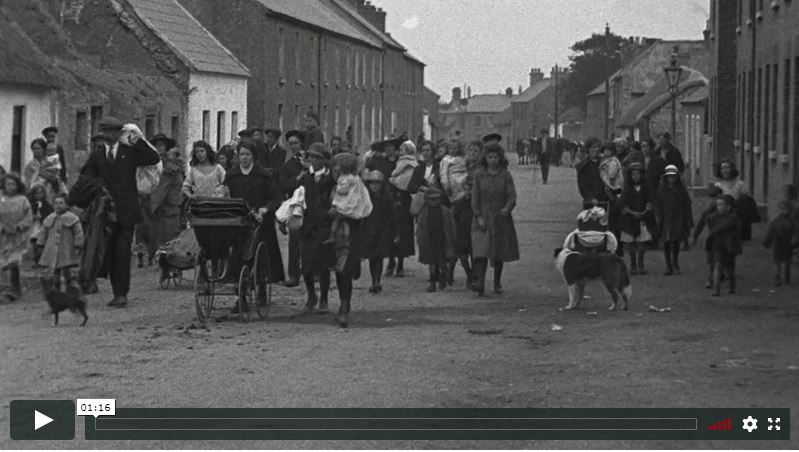Film and Cinema
 1. Watch
1. Watch
Cinema new and cinema memories
Before we all had televisions people would go to the cinema not just to watch the film but also for their weekly dose of news.
Click on the picture or link below to watch an old British Pathe newsreel – Lawless Ireland. There is no sound to the video unlike the piece we watched from 1954.
It was taken during The War of Independence following an incident known as The Sack of Balbriggan. During the night of September 21st 1920, the Black and Tans sacked the town of Balbriggan in County Dublin. The sacking was revenge for the killing of District Inspector Burke and his brother Sergeant Burke. They were shot dead by the IRA while in Smyth’s pub, Balbriggan, earlier in the day.
The Sack of Balbriggan to be commemorated
September 19, 2003

Balbriggan – Original author and uploader was Gvjekoslav at en.wikipedia / Public domain
A MASS and wreath laying ceremony will take place in Balbriggan to commemorate the Sack of Balbriggan which took place on the terrible night of September 20, 1920.
The rampage by the notorious ‘Black and Tans’ on the night of Monday, September 20 was in reprisals for the deaths of District Inspector Burke RIC and his brother Sergeant Burke who were shot dead while in Smyth’s pub, Balbriggan earlier that day.
The sack began around 11pm as lorries loaded with Black and Tans arrived in the town from the barracks at Gormanston and directly proceeded to shoot, burn and loot the town in a systematic spree of horrific violence.
In Clonard Street, 20 houses were destroyed leaving helpless and terrified inhabitants to flee into the fields surrounding the town.
Several pubs were looted and burned including Derham’s Pub and McGowan’s pub on George’s Hill.
Local businesses were also targeted with Deeds and Templar Hosiers, an English-funded company, completely destroyed.
This factory had employed 130 workers and an additional 180 who did work for it from home, according to Pat O’Neill who compiled a factual account on the Burning of Balbriggan.
There was only one house targeted on Hampton Street and it was that of John Gibbons, who was taken for questioning concerning the shootings earlier that day.
Also at the barracks was the town’s barber James Lawless, both men protesting their innocence.
They were later taken to Quay Street where they were beaten to death, their bodies found the next morning as the smoke from burned out town still rose in an eerie silence.
A terrified population sought refuge wherever they could, many going to Dublin to stay with relatives as news of the carnage spread throughout the land.
Others with nowhere to go or those who did not want to leave slept in makeshift straw homes in the fields around the town.
On Thursday morning, a local businessman, Mr Gallen, paid for families with no homes to travel to distant relatives.
A subsequent inquiry put the blame firmly at the doorstep of the British forces and awarded compensation to the families of Lawless and Gibbons of £1,750 each, which was to be paid by the ratepayer.
Also levied to the county was damages totalling over £80,000 with costs for Deeds and Templar which an inquiry heard had left 200 unemployed and would take two-and-a-half years to rebuild. Numerous other claims were settled for destroyed businesses, homes and damages to other property incurred over the night of Monday, September 20.
The full article can be read here: https://www.independent.ie/regionals/fingalindependent/news/the-sack-of-balbriggan-to-be-commemorated-27776467.html
Question 2
Having read the article, go back and watch the footage again. Is it more meaningful this time? Do you think any differently about the people in it or did you notice anything new in the footage?
Question 3
Tell me about your memories of going to the cinema? Are you old enough to remember the newsreels? When writing your piece think about the following – what cinema did you go to, how much was it, who did you go with, what goodies would you eat, what did it look like, what films did you go to see.
You can write a piece, record a video or your voice on your phone or draw a picture to tell your story.
 4. Visit:
4. Visit:
The Irish Film Institute is in Temple Bar. Click here www.ifi.ie to visit its website. When things are back to normal you can click on the What’s On section to see a list of the new and old films they are showing each month.
In the meantime visit their archive website www.ifiplayer.ie and search the Collections section to see old footage – from British Pathe to Radharc documentaries to old Irish ads – it is a real treasure trove.








